Abstract
Cholesta-5,7,9(11)-trien-3β-ol (9,11-dehydroprovitamin D3, CTL) is used as a fluorescent probe to track the presence and migration of cholesterol in vivo. We recently described the photochemistry and photophysics of CTL in degassed and air-saturated tetrahydrofuran (THF) solution, an aprotic solvent. The zwitterionic nature of the singlet excited state, 1CTL* is revealed in ethanol, a protic solvent. In ethanol, the products observed in THF are accompanied by ether photoadducts and by photoreduction of the triene moiety to four dienes, including provitamin D3. The major diene retains the conjugated s-trans-diene chromophore and the minor is unconjugated, involving 1,4-addition of H at the 7 and 11 positions. In the presence of air, peroxide formation is a major reaction channel as in THF. X-ray crystallography confirmed the identification of two of the new diene products as well as of a peroxide rearrangement product.
1. Introduction
Cholesta-5,7,9(11)-trien-3β-ol (CTL) and its close relative, 9(11)-dehydroergosterol (DHE) are natural products [1,2,3,4,5,6] that possess fluorescent [7] conjugated triene moieties embedded in the rigid cholestane skeleton.
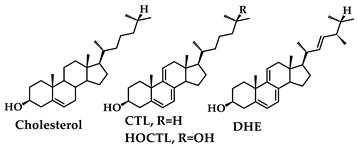

CTL differs from cholesterol only by the two additional double bonds at the C7 and C9 positions and DHE also differs in the side chain at C17. Consequently, CTL and DHE have been used as fluorescence probes for studies of cholesterol trafficking and membrane organization in vivo [8,9,10,11]. Because CTL and DHE are photochemically active, their fluorescence intensity decreases on prolonged excitation leading to photobleaching and fluorescence recovery studies [12]. Our initial studies of the photochemistry and photophysics of CTL and its 25-hydroxy derivative, HOCTL, were carried out in tetrahydrofuran (THF), an aprotic solvent [13]. The presence of the OH substituent at C25 of CTL led to facile crystallization of photoproducts and allowed us to confirm results from early pioneering studies by the Windaus and Barton groups [14,15,16] using X-ray crystallography (Scheme 1) [13]. The peroxide had been obtained from DHE by eosin sensitization [14,15] and its structure was proposed by Fieser [17] before the role of 1Δg singlet oxygen (1O2*) in such reactions was known. 1O2* luminescence observed on irradiation of an air-saturated solution of CTL in CCl4 established the formation of CTL triplets that transfer energy to 3O2 [18].
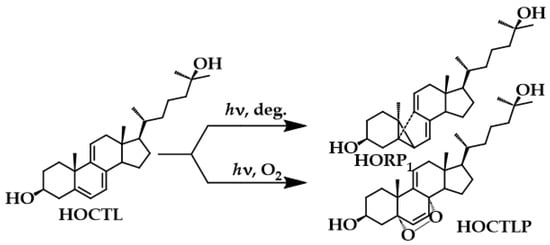
Scheme 1.
Photochemistry of HOCTL in THF.
Followed by UV, the loss of CTL or HOCTL in THF is accompanied by the appearance of a structureless peak at 261 nm due to the formation of the rearranged products RP1 or HORP1 [13]. In contrast, a 1930 study found that upon direct excitation of DHE in ethanol, the λmax of the photoproduct mixture is at 243 nm [19]. We resolve this discrepancy by showing that on irradiation of HOCTL in degassed ethanol the rearranged product (HOP1, 37%) is accompanied by formation of at least two ethers: 6α-ethoxy-3β-cholesta-7,9(11)-diene-3,25-diol (HOE1, 24.5%) and 6β-ethoxy-3β-cholesta-7,9(11)-diene-3,25-diol (HOE2, 13.4%); and four dienes: 3β-cholesta-7,9(11)-diene-3,25-diol (HOD1, 9.1%), 3β-cholesta-5,7-diene-3,25-diol (HOPro, 3.0%), 3β-cholesta-5,8-diene-3,25-diol, (HOD2 0.7%), and 3β-cholesta-6,8-diene-3,25-diol (HOD3, 8.2%) (Scheme 2). In the presence of air, at high CTL concentrations, peroxide formation is the dominant reaction in both solvents. The 25-OH substituent does not influence the photochemistry or photophysics. During the HPLC purification of HOCTLP, we isolated a hitherto unknown rearrangement product.

Scheme 2.
Additional photoproducts from HOCTL in ethanol.
2. Results
2.1. Photochemical Observations
A degassed 3.0 mL aliquot of HOCTL (5.43 × 10−5 M, contaminated with 2% HOPro) in ethanol was irradiated in a 13 mm Pyrex test tube provided with a sidearm to which a 0.50 × 1.0 cm quartz cell was attached via a graded seal. Figure 1 shows the UV evolution of HOCTL irradiated at λexc = 313 nm at 24.0 °C (time sequence 0, 10, 20, 30, 40, 60, 80, 100, 120, 180, 270 and 360 min). The photoproduct mixture has λmax = 244 nm and an isosbestic point is maintained at 279 nm. Similar results were obtained in parallel experiments on CTL.
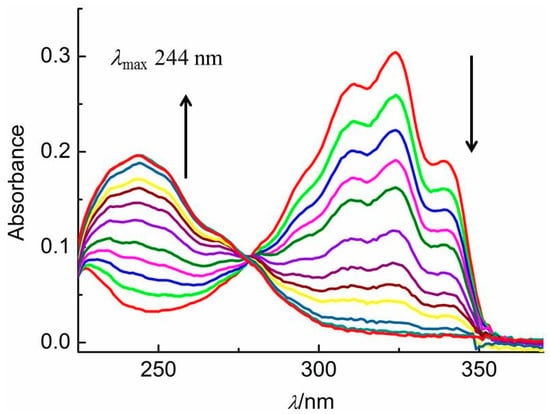
Figure 1.
Irradiation of [HOCTL]0 = 5.43 × 10−5 M in ethanol.
2.2. Photoproducts
For product isolation and identification, we irradiated 520 mL of a HOCTL (2.65 × 10−4 M, contaminated with 5% HOPro) solution in a Hanovia reactor using a 450 W Hanovia Hg lamp and the 313 nm filter solution. The solution was outgassed with Ar for 1.0 h prior to the irradiation and a constant flow of Ar was maintained during the irradiation. The progress of the photoreaction was monitored by UV-vis spectroscopy and near completion was achieved after 6 h. The solution was concentrated with a Büchi rotary evaporator and taken to dryness to remove ethanol using a vacuum pump. The 1H NMR of the crude mixture was recorded in CD3OD, (Figure S1 in the Supporting Information, SI). The mixture was then dissolved in 1.0 mL CHCl3 and injected onto the semi-preparative HPLC column. Initial elution with hexane/ethanol with ethanol gradually increasing from 0 to 3% was followed by up to 70% ethanol to wash all ethers from the column. The flow rate was 5 mL/min, 5.0 mL fractions were collected and the progress of the separation was followed by UV. Separation of HOPro, HOCTL, HORP1, HOD1 and HOD2 was challenging due to very similar retention times. HOPro, HOD1, HOCTL, and HORP1 eluted in fractions containing 1.43–1.45% ethanol. The earliest fractions containing mainly HOPro were discarded. Fractions rich in HOD1 were in the 1.43–1.44% ethanol range and fractions rich in HORP1 eluted with 1.44–1.45% ethanol. HOD1 fractions were combined, concentrated, dried and dissolved in 1.0 mL CHCl3 and separately chromatographed using hexane/ethyl acetate as the solvent system with ethyl acetate gradually increasing from 0 to 20%. Pure HOD1 was collected in 2–3 mL fractions at 14.8% ethyl acetate. HORP1 fractions were also combined and subjected to a third chromatography with hexane/ethyl acetate eluent. Pure HORP1 was collected in 0.6 mL fractions at 11.5% ethyl acetate. The final fractions from the first chromatography containing HOE1 and HOE2 were combined, concentrated, dried, dissolved in 1 mL CHCl3 and re-chromatographed using the hexane/ethanol solvent system. Pure HOE1 and pure HOE2 were collected in fractions containing 2.4 and 2.6% ethanol, respectively. The 1H NMR of pure HORP1 above was identical to the spectrum we reported for the rearrangement product in THF [13]. Its UV spectrum was also identical to the spectrum we observed in THF except that its λmax shifted from 261 nm in THF to 259 nm in ethanol. The UV spectra of the conjugated s-trans-diene, HOD1, λmax = 242 nm, and of the s-trans-diene ether products, HOE1 and HOE2, λmax = 243 nm, account for the λmax of the product mixture in Figure 1. Windaus et al. reported λmax = 245 nm [20] for 3β-Δ7,9-cholestadienol and a more recent measurement gave λmax = 243 nm [21,22]. The UV spectra of HOD1 and HOE1 are very similar (Figure 2), reflecting the shared presence of the s-trans-diene chromophore. The UV spectrum of HOE2 is relatively structureless (Figure S2). Isolation of the unconjugated diene, HOD2, was serendipitous as it appeared as crystals in one of the chromatography fractions.
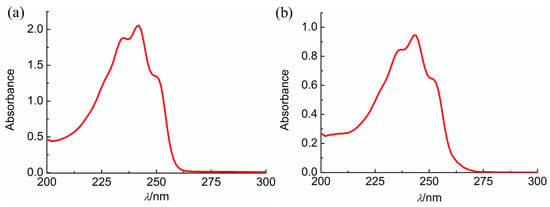
Figure 2.
UV spectra of (a) HOD1 and (b) HOE1 in ethanol.
1H NMR spectra of the photoproducts are shown in Figures S3–S6 in the Supplementary Materials. They are as follows: Figure S3, HOD1 (CD3OD, 500 MHz, δ): 5.49 (1H, d), 5.39 (1H, s), 3.50 (1H, m), 2.27–2.35 (1H, dd), 2.18 (1H, t), 2.11 (1H, d), 1.98 (2H, m), 1.89 (2H, m), 1.74–1.87 (2H, m), 1.69 (1H, m), 1.30–1.53 (17H, m), 1.17 (6H, s), 1.07 (1H, m), 0.97 (3H, d), 0.92 (3H, s), 0.54 (3H, s). Figure S4, HOD2 (CDCl3, 500 MHz, δ): 5.43 (1H, t), 3.54 (1H, m), 2.53 (2H, m), 2.26–2.38 (2H, m), 2.06–2.21 (3H, m), 1.96–2.03 (1H, m), 1.83–1.95 (4H, m), 1.26–1.70 (23H, m), 1.21 (3H, s), 1.19 (3H, s), 0.99–1.10 (3H, m), 0.95 (3H, s), 0.65 (3H, s). Figure S5, HOE1 (CD3OD, 500 MHz, δ): 5.57 (1H, d), 5.43 (1H, s), 3.73 (1H, m), 3.58 (1H, d), 3.47 (2H, m), 2.35 (1H, dd), 2.10–2.27 (4H, m), 1.9–2.06 (3H, m), 1.77–1.88 (3H, m), 1.23–1.55 (18H, m), 1.18–1.23 (3H, t), 1.17 (8H, s), 0.97 (6H, t) 0.55 (3H, s). Figure S6, HOE2 (CD3OD, 500 MHz, δ): 5.67 (1H, d), 5.40 (1H, s), 3.91 (1H, t), 3.67 (1H, s), 3.60 (2H, m), 2.40 (1H, dd), 2.36–2.43 (1H, dd), 2.22–2.28 (1H, t), 2.16–2.22 (1H, d), 1.94–2.06 (3H, m), 1.59–1.85 (5H, m), 1.23–1.58 (18H, m), 1.15–1.23 (13H, m), 1.07 (m, 2H), 0.97 (3H, m), 0.91 (1H, m), 0.61 (1H, s).
1H NMR spectra of HOD1 and HOD2, but without the 25-OH group, are known [23]. The α-ethoxy assignment to HOE1 is based on its COSY and NOESY 1H NMR spectra. The COSY spectrum (Figure S7) allowed the assignment of the C6 proton at δ 3.58 (d, J 10 Hz–due to coupling to the C5 proton) based on its being correlated to the C7 vinyl proton at δ 5.43 (broad s) (Figure S8 (expanded region of Figure S7)). The vinyl H at C11 at δ 5.57 (d) is correlated with the C12 protons at δ 2.35 (dd) (Figure S9 (expanded region of Figure S7)). The proximity of the C6 proton to the protons of the C17 methyl group, revealed by the NOESY spectrum (Figure S10) established its β orientation and the α disposition of the ethoxy group. Additional support for our assignment is provided by the 1H NMR spectra in CDCl3 of the analogous Δ7 compounds shown below [24].
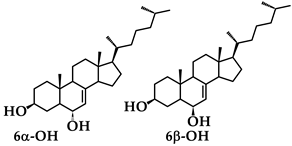

The vinyl Hs at C7 of 6α-OH and 6β-OH appear at δ 5.18 (br s) and 5.45 (br d), respectively, and the Hs at C6 appear at 3.8 (m) and 3.92 (m) in the same order. We observed the same chemical shift difference in the same direction for the C6 proton in HOE1 (δ 3.58) and HOE2 (δ 3.68), Also significant is the appearance of the C7 vinyl Hs of 6α-OH and HOE1 as broad singlets and the C7 vinyl Hs of 6β-OH and HOE2 as broad doublets.
HOCTLP, a major product from the irradiation of HOCTL in ethanol in the presence of air [13], was also purified by semi-preparative HPLC. During a purification run, we noticed the formation of small crystals in one of the fractions. Recrystallization from ethanol gave X-ray quality needle-like crystals that correspond to a peroxide rearrangement product, RP2, with a 5-membered A ring and a 7-membered B ring (Scheme 3). The 1H NMR spectrum of the compound recorded in CDCl3 is shown in Figure S9. Characteristic peaks in the 1H NMR spectrum of RP2 in CDCl3 were a singlet at δ 13.94 for the hydrogen-bonded OH proton and a triplet at δ 5.460 for the single vinyl proton.
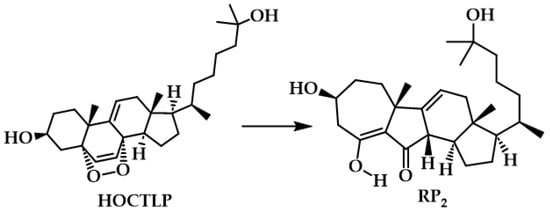
Scheme 3.
HOCTLP thermal rearrangement.
2.3. X-ray Structures
We concentrated our studies on HOCTL because of the relative ease of obtaining good-quality crystals when the 25-hydroxy group is present. Definitive structure assignment to the two diene photoproducts, HOD1 and HOD2, was achieved using X-ray crystallography (Figure 3). The X-ray crystal structure of the peroxide rearrangement product is shown in Figure 4. Mercury cif files and structural details are provided in Tables S1–S22 in the Supplementary Materials.
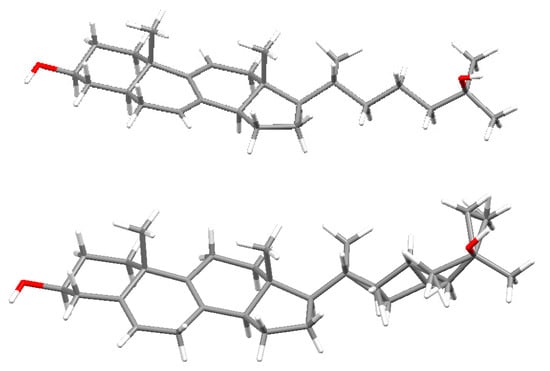
Figure 3.
X-ray crystal structures of HOD1 (upper) and HOD2 (lower).

Figure 4.
X-ray crystal structure of RP2, the peroxide rearrangement product.
2.4. Photoproduct Quantum Yields
The quantum yield measurement of HORP1 formation in ethanol was carried out in parallel with the previously described experiment [13] in THF. HOCTL contaminated with 11% Pro based on 1H NMR and UV analysis was used. Three-milliliter aliquots of degassed HOCTL solutions, 4.01 × 10−3 M in ethanol, were irradiated in the Moses merry-go-round [25] in parallel with the 3.0 mL 4.27 × 10−2 M degassed pentane solution of trans-stilbene, t-St, (0.011% cis-stilbene by GC), used for actinometry. The samples were immersed in a water bath whose temperature was maintained at 25 °C. A 450 W Hanovia lamp was employed together with the 313 nm filter solution. Pro is transparent at λexc = 313 nm and does not interfere with these measurements. Following 12 h irradiation, HOCTL conversions to HORP1 based on the relative areas of the vinyl protons being 7.4% in ethanol (1H NMR), while trans- → cis-stilbene conversion corrected for backreaction [26] was 12.38 ± 0.23% cis-stilbene. With the use of ϕtc = 0.52 in the actinometer [25], we obtain ϕHORP1 = 0.024 in ethanol. This experiment was repeated with pure HOCTL, 1.0 × 10−3 M, and [t-St] = 4.01 × 10−2 M, as above, except that the irradiation was carried out with a 550 W lamp at 26.4 °C. Conversions were 8.33% HORP1 and 4.46% c-St (corrected) confirming the ϕHORP1 = 0.024 value.
The presence of an isosbestic point in the UV spectra in Figure 1 and the fact that spectral matrices obtained in similar experiments on PCA-SM treatment behave as robust two-component systems (see Figures S10 and S11 in the Supplementary Materials), shows that the product composition is maintained throughout the photoreaction. Therefore, the final photoproduct composition reflects the relative formation quantum yields. The experiment was repeated without any HOPro contaminant in order to establish HOPro as a photoproduct. The vinyl and the C18 methyl protons contribute almost uniquely to the spectra and were used to determine the product composition. Expanded NMR regions in CD3OD from the irradiation of pure HOCTL are shown in Figure 5. Quantum yields were obtained from product contributions, determined by cutting and weighing in triplicate the vinyl and C18 methyl peaks, and setting the masses of the HORP1 peaks equal to a quantum yield of 0.024. Only in the case of HOD2 were chemical shifts based on spectra measured in CDCl3 (see Supplementary Materials). The two 1H NMR analyses give remarkably similar product yields (see the Supplementary Materials), the averages of which are shown in Table 1. The isolated photoproducts account for 88% of HOCTL loss.
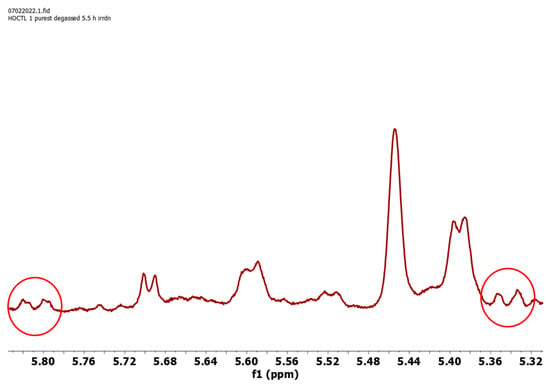
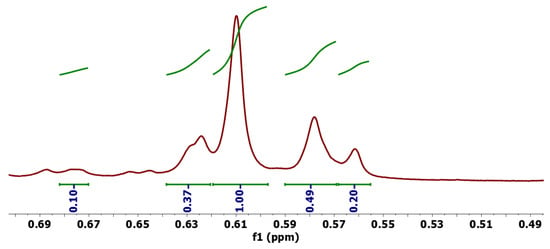
Figure 5.
Enlarged vinyl and methyl regions in the 1H NMR spectrum in CD3OD of the photoproduct mixture in ethanol (Figure S1).

Table 1.
Photoproduct quantum yields in degassed ethanol, 25 °C a.
In the presence of air, peroxide formation becomes the dominant photoreaction. Furthermore, as in THF [13], the relative yield of peroxide increases at higher CTL or HOCTL concentrations. Measurements in ethanol were carried out in parallel with those described for THF [13]. Peroxide quantum yields as a function of [HOCTL] are given in Table 2.

Table 2.
Peroxide (HOCTLP) quantum yields, 24 °C.
2.5. Fluorescence Measurements
We determined the effect of O2 on HOCTL fluorescence intensity and fluorescence lifetime by measuring the fluorescence of Ar-bubbled, air-saturated and O2-bubbled ethanol solutions (Table 3). For the fluorescence quantum yield measurements, the temperature in the jacketed cuvette was maintained at 20.0 °C by circulating cold water from a Neslab RTE-4DD heating/cooling bath. Values measured at 25 °C, are also shown in Table 3. For the lifetime measurements, samples were excited with a 295 nm, <0.75 ns diode pulse, and fluorescence decay was monitored at 367 nm at room temperature T (20.3 °C). Average lifetime values and the range of χ2 values are given in Table 3. A second minor (3–5%) longer-lived component (3–6 ns) was ignored, as it is probably due to an impurity. We calculated the [O2] values in Table 3 for air- and O2-saturated ethanol using O2 mole fraction data [27], the density [28] and the vapor pressure of ethanol at 20 °C [29].

Table 3.
O2 quenching of HOCTL fluorescence in ethanol, 20 °C.
2.6. HOCTL Triplet
A 3 mL aliquot of an ethanol solution containing 3.79 × 10−3 M HOCTL and 2.5 × 10−3 M benzophenone was transferred into a Pyrex tube equipped with a standard taper joint, provided with a grease trap and attached via a graded seal to a standard 1.0 cm2 UV cell. The solution was degassed using six freeze-pump-thaw cycles to <10−4 Torr and flame-sealed at a constriction. Pulse excitation at 370 nm led to transient spectra recorded periodically in the 0–100 μs time scale. As in THF [13], in addition to the known transient absorptions of the benzophenone triplet and the benzophenone ketyl radical [30,31], we observed a new transient absorption, assigned to 3HOCTL*, with λmax = 390 nm and a shoulder at 408 nm (Figure 6a) slightly blue-shifted from the values in THF [13]. Decay monitored at 395 nm, Figure 6b, is monoexponential and gives τ = 73.5 μs.
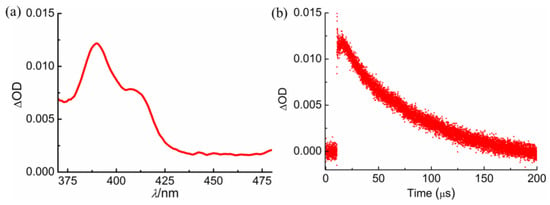
Figure 6.
(a) The 3HOCTL* transient. (b) Triplet decay at 395 nm.
3. Materials and Methods
3.1. Materials
Sources and purifications of 7-dehydrocholesterol (provitamin D3, Pro), 25-hydroxyprovitamin D3 (HOPro) as well as the syntheses and purifications of their 9(11) dehydro derivatives, CTL and HOCTL, were previously described [13]. Ethanol (Koptec, 200 proof, absolute/anhydrous), hexane (EMD, HPLC grade), CHCl3 (EMD, HPLC grade) and ethyl acetate (EMD, HPLC grade) were used as received.
3.2. Analytical Methods
Analysis of product composition was by GC, 1H NMR, UV-vis, fluorescence, MS and GC/MS, as previously described [13]. We employed a Beckman Ultrasphere 5 μm Si 250 × 10 mm column for semi-preparative HPLC purifications. The solvent systems used were hexane/ethyl acetate and hexane/ethanol for HOCTL photoproducts: 5 mL/min, monitored at 240 or 280 nm. UV-vis absorption spectra were measured on a Varian Cary 300B spectrometer. Fluorescence spectra were measured using a Horiba Fluoromax 4 fluorometer. Fluorescence lifetimes were determined using a different Horiba Fluoromax 4 instrument equipped with a time-correlated single-photon counting accessory and an R928 PMT detector (Hamamatsu). The light source was a 296 nm nanoLED (Horiba) having a pulse duration of <0.75 ns and a 1 MHz repetition rate. The photon count was set at 10,000 and the time-to-amplitude converter range was set at 50 ns. The instrument response function was obtained by collecting Rayleigh scatter at 296 nm. Fluorescence lifetimes were determined by reconvoluting the instrument response function with exponential decay using DAS6 (Horiba) fluorescence decay analysis software. The quality of the fits was judged by χ2 values, standard deviations of derived lifetimes and visual inspection of the residuals. Absolute fluorescence quantum yields were measured with the use of a Hamamatsu Quantaurus-QY spectrometer equipped with a 150 W Xenon arc lamp. The instrument employs an integrated sphere sample chamber with a cooled back-thinned 1024-channel charge-coupled device sensor as the detector. This avoids the need for a fluorescence standard by using the attenuation in the area of the Rayleigh scattered light peak at λexc = 325 nm to measure photon absorption. HOCTL solutions were outgassed with oxygen or argon for 2 h prior to quantum yield and lifetime measurements. Transient absorption measurements and triplet decay kinetics were measured using an Edinburgh Instruments LP980-KS Laser Flash Photolysis spectrometer. A Continuum Nd:YAG laser provided the excitation pulse and transient absorption was monitored with a 150 W Xenon lamp. A Bruker 500 MHz NMR spectrometer was used to measure NMR spectra in CDCl3 and CD3OD.
3.3. Crystallography
HOD1 and HOD3 crystals, approximately 0.33 × 0.24 × 0.07 mm3, were adhered to a MiTeGen loop with Paratone oil. Crystallographic data were collected at 150 K on a Rigaku-Oxford Diffraction XtaLAB-Synergy-S diffractometer with a Hypix-6000HE (Hybrid Photon Counting) detector, using Cu-Kα radiation of wavelength 1.54187 Å. The intensity data were measured by ω-scan with 0.5° oscillations for each frame with an intensity greater than 10:1 for the data-to-parameter ratio. The program suite CrysAlisPro was used for data collection, absorption correction, and data reduction. The structures were solved with the dual-space algorithm using SHELXT and were refined by full-matrix least-squares methods on F2 with SHELXL-2014 using the GUI Olex2 program [32]. HOP2 and HOP3, C27H44O2, crystallized in the orthorhombic crystal system, with the space group P212121. All non-hydrogen atoms were refined anisotropically. Hydrogen atoms were inserted at calculated positions or, if possible, based on difference Fourier analysis, and refined with a riding model or without restrictions.
3.4. Irradiation Procedures
Sample preparation and degassing procedures were described previously [26]. We used Hanovia reactors for preparative experiments and a Moses merry-go-round [25] apparatus, immersed in a thermostatted water bath, for quantum yield measurements. We employed medium-pressure 200 W and 450 W Hg lamps. The 313 nm Hg line was isolated using a filter solution prepared by dissolving potassium chromate, 0.4 g, and sodium carbonate, 1.50 g, in 1.0 L. This solution was also used in the THF experiments [13]. The trans → cis photoisomerization of stilbene in pentane (λexc = 313 nm was used for actinometry), ϕtc = 0.52 [26]. Pyrex tubes, 13 mm o.d., fitted with standard taper joints and grease traps were loaded with 3.0 mL aliquots of solutions. These were degassed using 4–6 freeze-pump-thaw cycles to <10−4 Torr and flame-sealed at a constriction. All operations, including analyses, were performed under nearly complete darkness (red light). Ar, N2 and O2 outgassed solutions were used in some experiments.
4. Discussion
The results in Table 1 show that 63% of the HOCTL photoproducts involve reaction with ethanol. Furthermore, 47% of the photoproducts, HOE1, HOE2 and HOD1 have the same s-trans heteroannular diene moiety. This conjugated 1,3-diene accounts for the shift in the photoproduct UV λmax from 260 nm in THF [13] to 244 nm in ethanol (Figure 1) [19]. With four ring residues and two exocyclic double bonds, the Woodward–Fieser rules [33,34] predict the λmax of all three s-trans-1,3-dienes to be at 244 nm, very close to the λmax in Figure 2 and Figure S2. Although HORP1 at 37% is the major photoproduct in degassed ethanol, it appears as a shoulder at ~260 nm in Figure 1 due to its significantly lower molar extinction coefficient [13].
4.1. Mechanism
Three mechanisms for the photoaddition of alcohols to olefins have been documented. One involves alkene photoionization followed by reaction of the radical cation with alcohol [35], the second involves photochemical formation of a high-energy ground state intermediate, such as a trans-cyclohexene [36,37], or a bicyclobutane [38,39] that reacts with alcohol, and the third involves trapping of an excited state twisted zwitterionic intermediate [40,41]. Dauben and Ritscher first proposed a zwitterionic excited diene state as the intermediate in the stereospecific photocyclization of trans-3-ethylidenecyclooctene to bicyclobutane [42]. Salem’s sudden polarization effect [43] close to orthogonal alkene geometries, confirmed recently by more advanced calculations on the stilbenes [44,45,46,47], provided theoretical support. Solvent effects on the lifetime of the tetraphenylethylene excited transient [48] as well as solvent [49,50,51,52,53] and substituent [54] effects on cis/trans photoisomerization, all support formation of twisted zwitterionic intermediates.
The photoreactions of CTL or HOCTL with ethanol are consistent with protonation of a zwitterionic excited state. The most relevant precedents for the addition and reduction photoproducts that we observed (Scheme 2) are the toxisterols B and R that were obtained from the over-irradiation of 7-dehydrocholesterol (Pro) in ethanol or methanol [55,56]. The over-irradiation of ergosterol leads to similar results judging from the evolution of UV spectra obtained in the course of the irradiation [57]. The B molecules are ethers that are thought to arise by 1,6-addition of alcohol to the conjugated triene moieties of previtamin D, Pre, and/or tachysterol, Tachy, and R, an unconjugated diene, is the product of a competing photoreduction. Diallyl zwitterionic intermediates were envisioned that undergo protonation at C9 followed by alkoxide addition or hydride transfer [56]. Two twisted diallyl zwitterions should be accessible from s-cis,s-trans- and s-cis,s-cis-conformers of either Pre or Tachy (Scheme 4). Protonation by methanol or ethanol at C6 of the zwitterions in Scheme 4 would give the planar pentadienyl cations shown in Figure 7 and Figure 8 of [55] paired with methoxide or ethoxide anions.
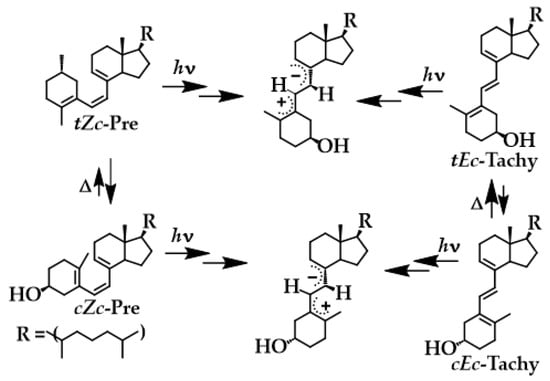
Scheme 4.
Orthogonal diallyl zwitterions from Pre and Tachy.
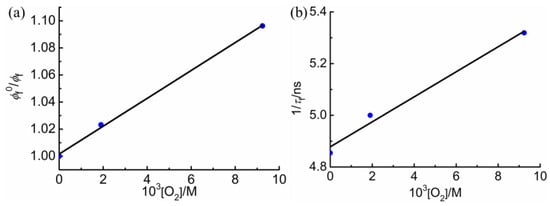
Figure 7.
Plots of the data in Table 3: (a) Stern–Volmer plot and (b) decay rates.
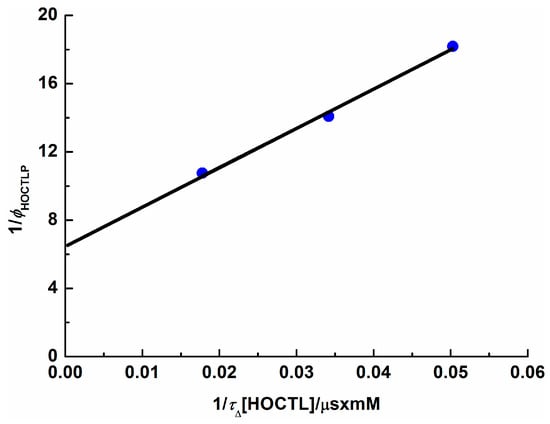
Figure 8.
The effect of [HOCTL] on ϕHOCTLP accounting for variation in τΔ.
The alkoxide counterion gives the observed ethers by coupling at C10 or the diene reduction products by hydride transfer at C6. Starting from different conformers of Pre and Tachy affords the desired pentadienyl cations [56] and avoids their proposed highly unlikely equilibration [57]. Havinga’s NEER principle now applies and there should be an excitation wavelength dependence on the composition of B and R toxisterols.
The alcohol photoreactions with CTL and HOCTL are simpler than those shown in Scheme 4 because the structural rigidity of the conjugated triene chromophore eliminates s-cis-/s-trans-conformer equilibration and cis-/trans-isomerization from consideration. Three of the new photoproducts in ethanol, HOE1, HOE2 and HOD1 can form by protonation at C5 to yield an ion pair that collapses to the ether products or, via hydride transfer, to the diene, by reaction at C6 (Scheme 5). Scheme 5 shows the three resonance structures of the pentadienyl cation and the resonance hybrid. It also shows Pauling bond order calculations indicating that, if the ethoxide ion could freely move along the conjugated cation, the principle of least nuclear motion would favor reactions at C8 [58,59]. Because all three major photoproducts involve reaction of the ion pair at C6, it appears that the reaction is controlled by the proximity of the nascent ethoxide anion to the positive site [60]. Protonation at C11 gives a pentadienyl cation that could form the minor reduction photoproducts, HOPro and HOD2 (Scheme 6). The proximity of the nascent ion pair favors hydride transfer at C9 to give HOPro, whereas the principle of least nuclear motion in the cation favors hydride transfer at C7 to give HOD2. We tend to discard the idea that two molecules of ethanol react with S1 of HOCTL in a concerted fashion, one to deliver a proton and the other to deliver ethoxide or hydride, because ethoxide should be a much better hydride donor than ethanol. Hydride transfer can give the endocyclic conjugated s-cis-1,3-diene, HOD3, shown on the right at the bottom of Scheme 5 and Scheme 6. Although not isolated, there is strong evidence that it is present. The vinyl protons of the known 1H NMR spectrum of this diene without the 25-OH group [23] appear as a pair of doublets at δ 5.817 and 5.377. They are almost coincident with the pair of doublets at δ 5.810 and 5.343 in the 1 H NMR spectrum of the product mixture (circled in Figure 5). Based on the area of the vinyl proton signals this product accounts for 8.2% of HOCTL loss.
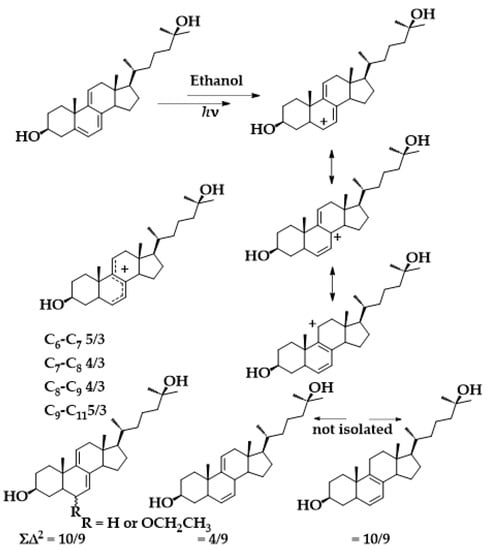
Scheme 5.
Protonation of S1 of HOCTL at C5.
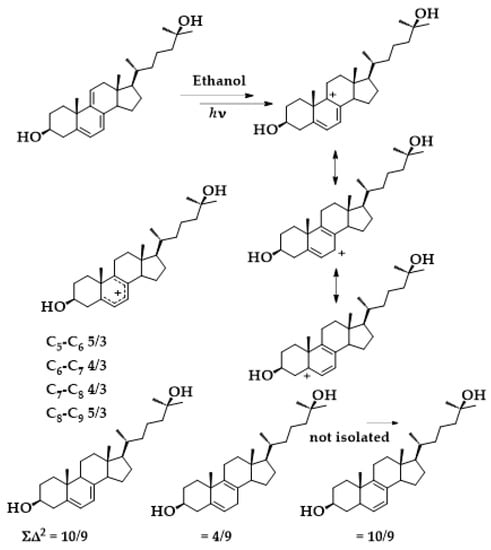
Scheme 6.
Protonation of S1 of HOCTL at C11.
4.2. Photochemical Kinetics
Except for the photoreactions with ethanol, the reaction sequences that account for the photochemistry of CTL or HOCTL in degassed or air-saturated ethanol are the same as for THF [13]. In both solvents, Equations (1)–(6) apply under degassed conditions, and Equations (7)–(10) are additional steps in the presence of O2. We do not show singlet oxygen, 1O2*, formation in Equation (7) because it was shown not to form in THF [13].
Under all conditions, Pe designates the sum of all ether and reduction photoproducts in ethanol (Equation (11)). Because their composition does not change as the reaction proceeds to completion, the sum of the pseudo unimolecular rate constants involved in their formation is designated ke.
4.3. Photophysics
The ϕf/τf ratios in Table 3 give kf = 1.72 × 108 s−1 at 20 °C (Equation (12)), where τs = (kf + kp + kis + kd + ke)−1. The significant deviation of this value from 1.45 × 108 s−1, the value we reported recently for HOCTL in THF at 20 °C [13] led us to re-examine the THF data in [13]. We found that while the lifetimes we had reported were indeed measured at 20 °C, the fluorescence quantum yields were measured at 22.8 °C. Table 3 shows that there is a significant increase in the ϕf of HOCTL on lowering the temperature from 25 to 20 °C. By interpolation, we expect a 14% increase in ϕf on lowering the temperature from 22.8 to 20.0 °C in ethanol. Applying this increase to the ϕf we reported for THF at 20 °C [13] under Ar-outgassed conditions gives kf = 1.70 × 108 s−1, in excellent agreement with the values in ethanol in Table 3. It places our values in the middle of the wide kf range that we calculated [13] from the data in Smutzer et al. in a variety of solvents [61] and well within experimental error of the value reported by Hyslop et al. in ethanol at 37 °C [62].
The effect of O2 on fluorescence quantum yields and lifetimes is given by Equations (13) and (14), respectively, where ϕf0 = kfτf0 and τf0 = (kf + kRP1 + kis + kd + ke)−1 are the fluorescence quantum yield and lifetime in the absence of O2. Plots of the data in Table 3 according to Equations (13) and (14) are shown in Figure 7. The slope of the lifetime plot in Figure 7a gives and the slope of the Stern–Volmer plot in Figure 7b gives . These values are the same within experimental error and indicate that oxygen quenching of 1HOCTL* in ethanol is diffusion controlled as in THF [13].
The lowest excited singlet and triplet lifetimes of HOCTL in ethanol, 0.206 ns and 73.5 μs, respectively, are about 10% smaller than in THF [13]. The smaller 1HOCTL* lifetime in ethanol was expected due to the additional photoreactions with the solvent.
4.4. Photochemistry
Application of the steady-state approximation on all excited species in the above mechanism leads to the quantum yield expression in Equation (15) for rearrangement product formation, where kp1 is the rearrangement rate constant in Equation (3). Our quantum yield for HORP1 formation in degassed ethanol, 0.024, and τs = 0.206 ns from Table 3 give kP1 = 1.17 × 108 s−1 for HOCTL, essentially identical to the value we obtained for the rearrangement rate constant in THF [13]. Quantum yields for the additional photoproducts in ethanol are given by Equation (16), where ke is the pseudo-unimolecular rate constant for the trapping of 1HOCTL* by ethanol in Equation (11) and fn are the fractions of the cations in Scheme 5 and Scheme 6 that give addition or reduction product Pn. Assuming that ethanol trapping is exclusively by protonation and that cation formation is irreversible, ke = 1.99 × 108 s−1. It is important to note that all identified ethanol photoproducts involve protonation at C5 or C11 the two terminal positions of the triene moiety with a strong preference for the C5 position. Those reactions give pentadienyl cations, confirming what JS was once told by Donald R. Arnold: “When a conjugated system gives a zwitterion, it does so by letting the positive charge occupy the biggest hole [63]”.
When the irradiation is carried out in ethanol in the presence of O2, the formation of peroxide is subject to the same considerations that we described in detail for the reaction in THF [13]. Accordingly, the peroxide quantum yields in Table 2 were treated using Equation (17), where τΔ and ϕΔ are the lifetime and formation quantum yield of 1O2*, respectively.
The presence of 11% HOPro as a contaminant in the HOCTL used in this experiment causes a variation in τΔ as shown in Equation (18). HOPro competes for 1O2* but not for the light.
A summary of the many measurements of the lifetime, τdox = 1/kdox, of 1O2* in pure ethanol has been presented [64], and they are in reasonable agreement. We choose to use the largest of these, 15.3 ± 0.7 μs [65], because reaction of singlet oxygen with the sensitizer used to produce it may reduce its lifetime. The overall rate constant of the reactions of 1O2* with Pro or HOPro, kPro, has not been measured in ethanol. Rate constants for the reactions of ergosterol [66] with 1O2* are 1.21 × 107 M−1s−1 and 2.1 × 107 M−1s−1 in tert-butyl methyl ether [67] and benzene [68], respectively. As in the case of THF [13], we estimated τΔ values in ethanol by assuming that the reactivities of Pro and HOPro with 1O2* in ethanol are the same as the reactivity of ergosterol in tert-butyl methyl ether. Those τΔ values are given in the third column of Table 2 and the plot of the peroxide quantum yields according to Equation (17) is given in Figure 8.
The intercept/slope ratio of the plot of the inverse of the peroxide quantum yield against 1/(τΔ[HOCTL]) in Figure 8 gives kper = 2.9 × 107 M−1s−1 in ethanol. The uncertainty in this value is large. It is larger than kper = 1.07 × 107 M−1s−1, the value we had estimated in THF. Our THF value was based on the use of τΔ = 30 μs [69] for the lifetime of singlet oxygen in pure THF. With the use of τΔ = 20 μs, the value supported by more recent publications [70,71], we obtain kper = 1.93 × 107 M−1s−1 in THF, in better agreement with our value in ethanol. The inverse of the intercept gives ϕΔ = ϕis = 0.16 in ethanol. With the use of τf = 0.20 ns from Table 3 we obtain kis = 8.0 × 108 s−1 for HOCTL in ethanol, in close agreement with our value in THF [13]. We estimate the uncertainty in these values to be ±30%.
Our literature search for HOCTLP thermal rearrangement products was not fruitful. It appears that HOCTLP is quite stable and that the rearrangement in Scheme 3 has not been reported previously. A plausible multistep mechanism for the reaction is given in Scheme 7. Although some of the steps are combined in the Scheme, we do not wish to imply that they are necessarily concerted. The first intermediate shown in Scheme 7 is a hydroperoxy-substituted carbocation. Although such species are common intermediates in reactions of peroxides, they are, counterintuitively, less stable than their hydroxy analogs [72,73]. Consequently, their subsequent transformation into (a) tertiary allylic cation and (b) oxacarbenium ion (i.e., the protonated ketone), is likely to be thermodynamically favorable. Note that the hydride shift shown in the second intermediate in Scheme 7 would form an oxacarbenium ion. So the rearrangement proceeds from a less stable hydroperoxycarbocation to a more stable hydroxycarbocation—i.e., downhill thermodynamically. A recent general reference describing the stabilization of cations by oxygen is available [74].
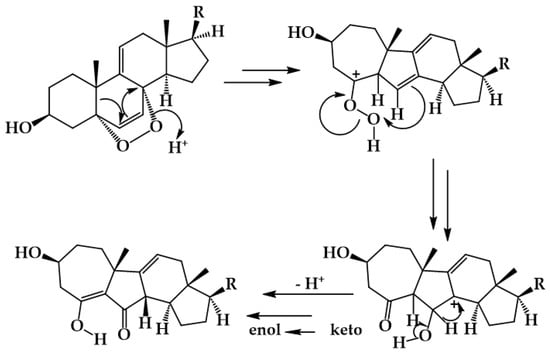
Scheme 7.
Possible mechanism for the rearrangement of HOCTLP to RP2.
The 7,6,6,5 A,B,C,D ring-size sequence in RP2 is unusual, as, to our surprise, we could find it in no reported natural product. Accordingly, we plan to seek optimum conditions for this reaction.
Supplementary Materials
The following supporting information can be downloaded at: https://www.mdpi.com/article/10.3390/molecules28104086/s1, Figure S1, 1H NMR spectrum of the final product mixture from the irradiation of HOCTL in Ar-outgassed ethanol; Figure S2, the UV spectrum of HOE2; Figures S3–S6, 1H NMR spectra of HOD1, HOD2, HOE1 and HOE2, respectively; Figure S7, COSY 1H NMR spectrum of HOE1; Figure S8, NOESY 1H NMR spectrum of HOE1; Figure S9, Expanded region of Figure S7 showing the correlation between the vinyl H at C11 and the H-6 proton. Figure S10, NOESY 1H NMR spectrum of HOE1 in CD3OD. Figure S11, 1H NMR spectrum of RP2 in CD3Cl. Figure S12. Time evolution of UV spectra from the 313 nm irradiation of CTL in ethanol. Figure S13, Combination coefficient plot for the spectra in Figure S12. X-ray structures: Tables S1–S7 of X-ray data consisting of crystallographic parameters, positional parameters, bond distances, bond angles and torsional angles for HOCTL; Tables S8–S14 and Tables S15–S21 for HOCTLP and HORP2, respectively. Mercury cif files for the three crystals. Table S22. Hydrogen Atom Coordinates (Å × 104) and Isotropic Displacement Parameters (Å2 × 103) for HORP2. Reference [1] in Supporting Information is also cited as reference [32] in the manuscript.
Author Contributions
S.B.K. provided most of the experimental work described in this paper. Preliminary experimental measurements were performed by S.G., A.C. and X.L. carried out the X-ray crystallographic measurements and determined the X-ray structures. J.S. directed the research and prepared the manuscript for publication in consultation with E.F.H. All authors have read and agreed to the published version of the manuscript.
Funding
This research was funded by the National Science Foundation, most recently by Grant No. CHE-1361962 and the Florida State University Research Foundation, project RF 04092.
Institutional Review Board Statement
Not applicable.
Informed Consent Statement
Not applicable.
Data Availability Statement
Experimental data (electronic and emission spectra, NMR data) are available from the authors upon reasonable request.
Acknowledgments
This work made use of the Rigaku Synergy-S single-crystal X-ray diffractometer which was acquired through the NSF MRI program (award CHE-1828362). This research used resources provided by the Materials Characterization Laboratory at the FSU Department of Chemistry and Biochemistry (FSU075000MAC). We thank J. S. Raaj Velore Winfred for his assistance with the ns transient absorption measurements.
Conflicts of Interest
The authors declare no conflict of interest. The funders had no role in the design of the study; in the collection, analyses, or interpretation of data; in the writing of the manuscript; or in the decision to publish the results.
Sample Availability
Not applicable.
References
- Ruan, B.; Wilson, W.K.; Pang, J.; Gerst, N.; Pinkerton, F.D.; Tsai, J.; Kelley, R.I.; Whitby, F.G.; Milewicz, D.M.; Garbern, J.; et al. Sterols in Blood of Normal and Smith-Lemli-Opitz Subjects. J. Lipid Res. 2001, 42, 799–812. [Google Scholar] [CrossRef]
- Ruan, B.; Wilson, W.K.; Tsai, J.; Schroepfer, G.J., Jr. Aberrant Pathways in the Late Stages of Cholesterol Biosynthesis. Origin and Metabolic Fate of Unsaturated Sterols Relevant to the Smith-Lemli-Opitz Syndrome. J. Lipid Res. 2000, 41, 1772–1782. [Google Scholar] [CrossRef] [PubMed]
- Delseth, C.; Kashman, Y.; Djerassi, C. Ergosta-5,7,9(11),22-tetraen-3β-ol and its 24-Ethyl Homolog. Two New Marine Sterols from the Red Sea Sponge Biemna fortis. Helv. Chim. Acta 1979, 62, 2037–2045. [Google Scholar] [CrossRef]
- Heald, S.I.; Jeffs, P.W.; Wheat, R.W. The identification of ergosterol and Δ9(11)-dehydroergosterol from mycelia of Coccidioides immitis by reverse-phase high-performance liquid and gas chromatography and ultraviolet and mass spectrometry. Exper. Mycol. 1981, 5, 162–166. [Google Scholar] [CrossRef]
- Gunatilaka, A.A.L.; Gopichand, Y.; Schmitz, F.J.; Djerassi, C. Minor and Trace Sterols in Marine Invertebrates. Isolation and Structure Elucidation of Nine New 5.alpha.,8.alpha.-Epidioxy Sterols from Four Marine Organisms. J. Org. Chem. 1981, 46, 3860–3866. [Google Scholar] [CrossRef]
- Sica, D.; Boniforti, L.; DiGiacomo, G. Sterols of Candida Tropicalis Grown on n-Alkanes. Phytochemistry 1982, 21, 234–236. [Google Scholar] [CrossRef]
- Fischer, R.T.; Stephenson, F.A.; Shafiee, A.; Schroeder, F. Δ5,7,9(11)-Cholestatrien-3β-ol: A Fluorescent Cholesterol Analogue. Chem. Phys. Lipids 1984, 36, 1–14. [Google Scholar] [CrossRef]
- Fischer, R.T.; Cowlen, M.S.; Dempsey, M.E.; Schroeder, F. Fluorescence of Δ5,7,9(11),22-Ergostatetraen-3β-ol in Micelles, Complexes, and Plasma Membranes. Biochemistry 1985, 24, 3322–3331. [Google Scholar] [CrossRef]
- Schroeder, F. Fluorescent Sterols-Probe Molecules of Membrane Structure and Function. Prog. Lipid Res. 1984, 23, 97–113. [Google Scholar] [CrossRef]
- Wüstner, D. Fluorescent Sterols as Tools in Membrane Biophysics and Cell Biology. Chem. Phys. Lipids 2007, 146, 1–25. [Google Scholar] [CrossRef]
- Maxfield, F.R.; Wüstner, D. Analysis of Cholesterol Trafficking with Fluorescent Probes. Methods Cell Biol. 2012, 108, 367–393. [Google Scholar] [CrossRef] [PubMed]
- Hao, M.; Lin, S.X.; Karylowski, O.J.; Wüstner, D.; McGraw, T.E.; Maxfield, F.R. Vesicular and Non-vesicular Sterol Transport in Living Cells. The Endocytic Recycling Compartment is a Major Sterol Organelle. J. Biol. Chem. 2002, 277, 609–617. [Google Scholar] [CrossRef]
- Saltiel, J.; Krishnan, S.B.; Gupta, S.; Hernberg, E.A.; Clark, R.J. Photochemistry and Photophysics of Cholesta-5,7,9(11)-trien-3β-ol—A Fluorescent Analogue of Cholesterol. Photochem. Photobiol. Sci. 2022, 21, 37–47. [Google Scholar] [CrossRef] [PubMed]
- Windaus, A.; Linsert, O. Ultraviolet Irradiation of Dehydroergosterol. Justus Liebigs Ann. Chem. 1928, 465, 148–166. [Google Scholar] [CrossRef]
- Windaus, A.; Gaede, J.; Köser, J.; Stein, G. Crystallized Irradiation Products from Ergosterol and Dehydroergosterol. Justus Liebigs Ann. Chem. 1930, 483, 17–30. [Google Scholar] [CrossRef]
- Barton, D.H.R.; Kende, A.S. The Constitution of a Steroidal Irradiation Product. J. Chem. Soc. 1958, 688–692. [Google Scholar] [CrossRef]
- Fieser, L.F. Steric Course of Reactions of Steroids. Experientia 1950, 6, 312–315. [Google Scholar] [CrossRef]
- Chignell, C.F.; Kukielczak, B.M.; Sik, R.H.; Bilski, P.J.; He, Y.-Y. Ultraviolet A Sensitivity in Smith–Lemli–Opitz Syndrome: Possible Involvement of Cholesta-5,7,9(11)-trien-3β-ol. Free Rad. Biol. Med. 2006, 41, 339–346. [Google Scholar] [CrossRef]
- Morton, R.A.; Heilbron, I.M.; Spring, F.S. Absorption Spectra in Relation to Vitamin, A. Biochem. J. 1930, 24, 136–140. [Google Scholar] [CrossRef]
- Windaus, A.; Linsert, O.; Eckhardt, H.J. Über Iso-dehydro-cholesterin (Δ6,Δ8-cholestadien-3-ol). Justus Liebigs Ann. Chem. 1938, 534, 22–41. [Google Scholar] [CrossRef]
- Nussim, M.; Mazur, Y.; Sondheimer, F. The Hydration of Unsaturated Steroids by the Brown Hydroboration Reaction. II. Steroidal Conjugated Dienes. J. Org. Chem. 1964, 29, 1131–1136. [Google Scholar] [CrossRef]
- Schroepfer, G.J., Jr.; Parish, E.J.; Kandutsch, A.A. Inhibitors of sterol biosynthesis. Synthesis and activities of ring C oxygenated sterols. Chem. Phys. Lipids 1988, 46, 147–154. [Google Scholar] [CrossRef] [PubMed]
- Wilson, W.K.; Sumpter, R.M.; Warren, J.J.; Rogers, P.S.; Ruan, B.; Schroepfer, G.J., Jr. Analysis of unsaturated C27 sterols by nuclear magnetic resonance spectroscopy. J. Lipid Res. 1996, 37, 1529–1555. [Google Scholar] [CrossRef] [PubMed]
- De Simone, F.; Dini, A.; Finamore, E.; Minale, L.; Pizza, C.; Riccio, R.; Zollo, F. Starfish Saponins. Part 5. Structure of Steroidal Cyclic Glycoside from Starfish Echinaster sepositus. J. Chem. Soc. Perkin Trans. 1 1981, 1855–1862. [Google Scholar] [CrossRef]
- Moses, F.G.; Liu, R.S.H.; Monroe, B.M. The “Merry-Go-Round” Quantum Yield Apparatus. Mol. Photochem. 1969, 1, 245–249. [Google Scholar]
- Saltiel, J.; Marinari, A.; Chang, D.W.-L.; Mitchener, J.C.; Megarity, E.D. Trans-Cis Photoisomerization of the Stilbenes and a Reexamination of the Positional Dependence of the Heavy-Atom Effect. J. Am. Chem. Soc. 1979, 101, 2982–2996. [Google Scholar] [CrossRef]
- IUPAC. Analytical Chemistry Division, Commission on Solubility Data, Oxygen and Ozone. In Solubility Data Series; Battino, R., Ed.; Pergamon: Oxford, UK, 1981; Volume 7. [Google Scholar]
- CRC. Handbook of Chemistry and Physics, 57th ed.; Weast, R.C., Ed.; CRC Press: Boca Raton, FL, USA, 1976. [Google Scholar]
- Scatchard, G.; Satkiewicz, F.G. Vapor-Liquid Equilibrium.XII. The System Ethanol-Cyclohexane from 5 to 65°. J. Am. Chem. Soc. 1964, 86, 130–133. [Google Scholar] [CrossRef]
- Godfrey, T.S.; Hilpern, J.W.; Porter, G. Triplet-Triplet Absorption Spectra of Benzophenone and its Derivatives. Chem. Phys. Lett. 1967, 1, 490–492. [Google Scholar] [CrossRef]
- Topp, M. Activation-Controlled Hydrogen Abstraction by Benzophenone Triplet. Chem. Phys. Lett. 1975, 32, 144–149. [Google Scholar] [CrossRef]
- Dolomanov, O.V.; Bourhis, L.J.; Gildea, R.J.; Howard, J.A.K.; Puschmann, H. Olex2: A complete structure solution, refinement and analysis program. J. Appl. Cryst. 2009, 42, 339–341. [Google Scholar] [CrossRef]
- Woodward, R.B. Structure and absorption spectra. III. Normal conjugated dienes. J. Am. Chem. Soc. 1942, 64, 72–75. [Google Scholar] [CrossRef]
- Fieser, L.F.; Fieser, M. Advanced Organic Chemistry; Reinhold Publishing Corp: New York, NY, USA, 1961; p. 204. [Google Scholar]
- Kropp, P.J. Photochemistry of Alkenes in Solution. Pure Appl. Chem. 1970, 24, 585–598. [Google Scholar] [CrossRef]
- Marshall, J.A. Photosensitized Ionic Additions to Cyclohexenes. Acc. Chem. Res. 1969, 2, 33–40. [Google Scholar] [CrossRef]
- Kropp, P.J.; Reardon, E.J., Jr.; Gaibel, Z.; Williard, K.F.; Hattaway, J.H., Jr. Photochemistry of Alkenes. Direct Irradiation in Hydroxylic Media. J. Am. Chem. Soc. 1973, 95, 7058–7067. [Google Scholar] [CrossRef]
- Dauben, W.G.; Wipke, W.T. Photochemistry of Dienes. Pure Appl. Chem. 1964, 9, 533–539. [Google Scholar] [CrossRef]
- Dauben, W.G.; Smith, J.H.; Saltiel, J. The Mass Spectra of Cyclobutyl and Cyclopropylcarbinyl Methyl Ethers and the Methanolysis of Bicyclobutane. J. Org. Chem. 1969, 34, 261–266. [Google Scholar] [CrossRef]
- Saltiel, J.; Redwood, C.E. Photochemistry of the 1,4-Diphenyl-1,3-butadienes in Ethanol. Trapping Conical Intersections. J. Phys. Chem. A 2016, 120, 2832–2840. [Google Scholar] [CrossRef]
- Saltiel, J.; Gupta, S. Photochemistry of the Stilbenes in Methanol. Trapping the Common Phantom Singlet State. J. Phys. Chem. A 2018, 122, 6089–6099. [Google Scholar] [CrossRef]
- Dauben, W.G.; Ritscher, J.S. Photochemistry of Ethylidenecyclooctenes. Mechanism of Bicyclobutane Formation. J. Am. Chem. Soc. 1970, 92, 2925–2926. [Google Scholar] [CrossRef]
- Salem, L. The Sudden Polarization Effect and Its Possible Role in Vision. Acc. Chem. Res. 1979, 12, 87–92. [Google Scholar] [CrossRef]
- Quenneville, J.; Martínez, T.J. Ab Initio Study of Cis-Trans Photoisomerization in Stilbene and Ethylene. J. Phys. Chem. A 2003, 107, 829–837. [Google Scholar] [CrossRef]
- Minezawa, N.; Gordon, M.S. Photoisomerization of Stilbene: A Spin-Flip Density Functional Theory Approach. J. Phys. Chem. A 2011, 115, 7901–7911. [Google Scholar] [CrossRef] [PubMed]
- Ioffe, I.N.; Granovsky, A.A. Photoisomerization of Stilbene: The Detailed XMCQDPT2 Treatment. J. Chem. Theory Comput. 2013, 9, 4973–4990. [Google Scholar] [CrossRef] [PubMed]
- Tomasello, G.; Garavelli, M.; Orlandi, G. Tracking the Stilbene Photoisomerization in the S1 State Using RASSCF. Phys. Chem. Chem. Phys. 2013, 15, 19763–19773. [Google Scholar] [CrossRef] [PubMed]
- Schilling, C.L.; Hilinski, E.F. Dependence of the Lifetime of the Twisted Excited Singlet State of Tetraphenylethylene on Solvent Polarity. J. Am. Chem. Soc. 1988, 110, 2296–2298. [Google Scholar] [CrossRef]
- Sundström, V.; Gillbro, T. Dynamics of the isomerization of trans-stilbene in n-alcohols by ultraviolet picosecond absorption recovery. Chem. Phys. Lett. 1984, 109, 538–543. [Google Scholar] [CrossRef]
- Kim, S.K.; Courtney, S.H.; Fleming, G.R. Isomerization of trans-Stilbene in Alcohols. Chem. Phys. Lett. 1989, 159, 543–548. [Google Scholar] [CrossRef]
- Saltiel, J.; Ko, D.-H.; Fleming, S.A. Differential Medium Effects on the Trans to Cis Photoisomerization of all-trans-1,6-Diphenyl-1,3,5-hexatriene. Competing Diradicaloid vs Zwitterionic Pathways. J. Am. Chem. Soc. 1994, 116, 4099–4100. [Google Scholar] [CrossRef]
- Saltiel, J.; Wang, S.; Watkins, L.P.; Ko, D.-H. Direct Photoisomerization of the 1,6-Diphenyl-1,3,5-hexatrienes. Medium Effect on Triplet and Singlet Contributions. J. Phys. Chem. A 2000, 104, 11443–11450. [Google Scholar] [CrossRef]
- Redwood, C.; Kumar, R.V.K.; Hutchinson, S.; Mallory, F.B.; Mallory, C.W.; Clark, R.J.; Dmitrenko, O.; Saltiel, J. Photoisomerization of cis-1,2-di(1-methyl-2-naphthyl)ethene at 77 K in glassy media. Photochem. Photobiol. 2015, 91, 607–615. [Google Scholar] [CrossRef]
- Squillacote, M.; Wang, J.; Chen, J. Electrostatic Control of the Regioselectivity in the Photoisomerization of trans,trans-1-Fluoro-2,4-hexadiene: Evidence for Competing Conical Intersections. J. Am. Chem. Soc. 2004, 126, 1940–1941. [Google Scholar] [CrossRef] [PubMed]
- Boomsma, F.; Jacobs, H.J.C.; Havinga, E.; van der Gen, A. The “over irradiation” products of previtamin D and tachysterol: Toxisterols. Recl. Trav. Chim. Pays Bas 1977, 96, 104–112. [Google Scholar] [CrossRef]
- Jacobs, H.J.C.; Boomsma, F.; Havinga, E.; van der Gen, A. The photochemistry of previtamin D and tachysterol. Recl. Trav. Chim. Pays Bas 1977, 96, 113–117. [Google Scholar] [CrossRef]
- Barrett, A.G.M.; Barton, D.H.R.; Russell, R.A.; Widdowson, D.A. Photochemical Transformations. Part 34. Structure of the Toxisterols. J. Chem. Soc. Perkin Trans. 1 1977, 631–643. [Google Scholar] [CrossRef]
- Hine, J. The principle of least nuclear motion. Adv. Phys. Org. Chem. 1977, 15, 1–61. [Google Scholar] [CrossRef]
- Reis, M.C.; Alajarin, M.; Marin-Luna, M. Violations to the principle of least motion: The shortest path is not always the fastest. Phys. Chem. Chem. Phys. 2022, 24, 8064–8075. [Google Scholar] [CrossRef]
- Nordlander, J.E.; Ownor, P.O.; Haky, J.F. Regiochemistry of the Addition of DCl to trans-1,3-Pentadiene. J. Am. Chem. Soc. 1979, 101, 1288–1289. [Google Scholar] [CrossRef]
- Smutzer, G.; Crawford, B.F.; Yeagle, P.L. Physical Properties of the Fluorescent Sterol Probe Dehydroergosterol. Biochim. Biophys. Acta 1986, 862, 361–371. [Google Scholar] [CrossRef]
- Hyslop, P.A.; Morel, B.; Sauerheber, D. Organization and Interaction of Cholesterol and Phosphatidylcholine in Model Bilayer Membranes. Biochemistry 1990, 29, 1025–1038. [Google Scholar] [CrossRef]
- Arnold, D.R. (Department of Chemistry, Dalhousie University, Halifax, NS, Canada). Personal communication.
- Redmond, R.W.; Heihoff, K.; Braslavsky, S.E.; Truscott, T.G. Thermal-lensing and phosphorescence studies of the quantum yield and lifetime of singlet molecular oxygen (1Δg) sensitized by hematoporphyrin and related porphyrins in deuterated and non-deuterated ethanols. Photochem. Photobiol. 1987, 45, 209–213. [Google Scholar] [CrossRef]
- Rodgers, M.A.J. Solvent-Induced Deactivation of Singlet Oxygen: Additivity Relationships in Nonaromatic Solvents. J. Am. Chem. Soc. 1983, 105, 6201–6205. [Google Scholar] [CrossRef]
- Ponce, M.A.; Ramirez, J.A.; Galagovsky, L.R.; Gros, E.G.; Erra-Balsells, R. A new look into the reaction between ergosterol and singlet oxygen in vitro. Photochem. Photobiol. Sci. 2002, 1, 749–756. [Google Scholar] [CrossRef] [PubMed]
- Albro, P.W.; Bilski, P.; Corbett, J.T.; Schroeder, J.L.; Chignell, C.F. Photochemical Reactions and Phototoxicity of Sterols: Novel Self-perpetuating Mechanism for Lipid Photooxidation. Photochem. Photobiol. 1997, 66, 316–325. [Google Scholar] [CrossRef] [PubMed]
- Gorman, A.A.; Hamblett, I.; Rodgers, M.A.J. Ergosterol (Provitamin D2) Triplet State: An Efficient Sensitiser of Singlet Oxygen, O2 (1Δg), Formation. Photochem. Photobiol. 1987, 45, 215–221. [Google Scholar] [CrossRef] [PubMed]
- Solokhiddinov, K.I.; Byteva, I.M.; Gurinovich, G.P. Lifetime of Singlet Oxygen in Various Solvents. Zhurnal Prikl. Spektrosk. 1981, 34, 892–897. [Google Scholar] [CrossRef]
- Hurst, J.R.; McDonald, J.D.; Schuster, G.B. Lifetime of Singlet Oxygen in Solution Directly Determined by Laser Spectroscopy. J. Am. Chem. Soc. 1982, 104, 2065–2067. [Google Scholar] [CrossRef]
- Sagadevan, A.; Huang, K.C.; Su, M.-D. Singlet Oxygen-Mediated Selective C-H Bond Hydroperoxidation of Ethereal Hydrocarbons. Nat. Commun. 2017, 8, 1812. [Google Scholar] [CrossRef]
- Juaristi, E.; dos Passos Gomes, G.; Terent’ev, A.O.; Notario, R.; Alabugin, I.V. Stereoelectronic Interactions as a Probe for the Existence of the Intramolecular α-Effect. J. Am. Chem. Soc. 2017, 139, 10799–10813. [Google Scholar] [CrossRef]
- Yaremenko, I.A.; Belyakova, Y.Y.; Radulov, P.S.; Novikov, R.A.; Medvedev, M.G.; Krivoshchapov, N.V.; Korlyukov, A.A.; Alabugin, I.V.; Terent’ev, A.O. Inverse α-Effect as the Ariadne’s Thread on the Way to Tricyclic Aminoperoxides: Avoiding Thermodynamic Traps in the Labyrinth of Possibilities. J. Am. Chem. Soc. 2022, 144, 7264–7282. [Google Scholar] [CrossRef]
- Alabugin, I.V.; Kuhn, L.; Medvedev, M.G.; Krivoshchapov, N.V.; Vil’, V.A.; Yaremenko, I.A.; Mehaffy, P.; Yarie, M.; Terent’ev, A.O.; Zolfigol, M.A. Stereoelectronic Power of Oxygen in Control of Chemical Reactivity: The Anomeric Effect is not Alone. Chem. Soc. Rev. 2021, 50, 10253–10345. [Google Scholar] [CrossRef]
Disclaimer/Publisher’s Note: The statements, opinions and data contained in all publications are solely those of the individual author(s) and contributor(s) and not of MDPI and/or the editor(s). MDPI and/or the editor(s) disclaim responsibility for any injury to people or property resulting from any ideas, methods, instructions or products referred to in the content. |
© 2023 by the authors. Licensee MDPI, Basel, Switzerland. This article is an open access article distributed under the terms and conditions of the Creative Commons Attribution (CC BY) license (https://creativecommons.org/licenses/by/4.0/).